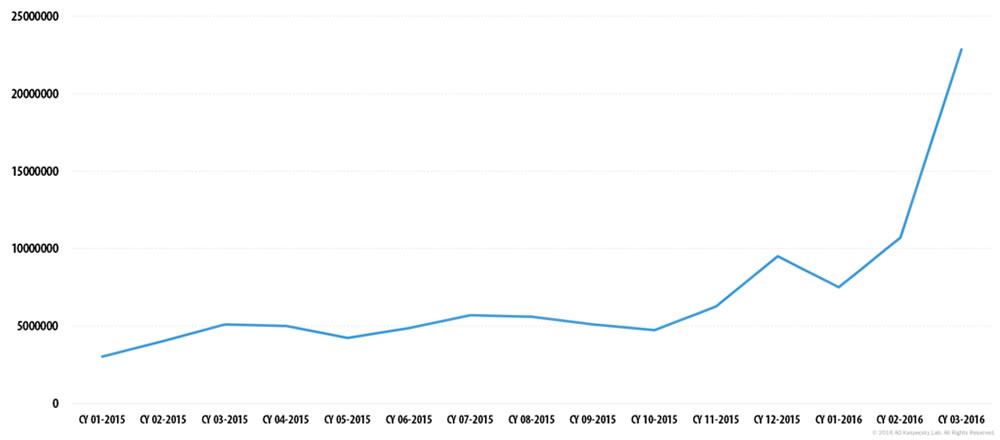According to a recent report on spam email from anti-virus software developer Kaspersky Lab, the decline in spam email over the past few years appears to have reversed, with the first quarter of 2016 seeing a major increase in malicious spam email volume.
Major Increase in Malicious Spam Email Volume Reported by Kaspersky Lab
Over the past few years there has been a decline in the number of spam emails, as cybercriminals have sought other ways to deliver malware and defraud computer users. In 2015, the volume of spam emails being sent fell to a 12-year low. Spam email volume fell below 50% for the first time since 2003.
In June 2015, the volume of spam emails dropped to 49.7% and in July 2015 the figures fell further still to 46.4%, according to anti-virus software developer Symantec. The decline was attributed to the taking down of major botnets responsible for sending spam emails in the billions.
Malicious spam email volume has remained fairly constant during 2015. Between 3 million and 6 million malicious spam emails were detected by Kaspersky Lab throughout 2015; however, toward the end of the year, malicious spam email volume increased. That trend has continued in 2016.
Kaspersky Lab figures show that spam email messages containing malicious attachments – malware, ransomware, malicious macros, and JavaScript – started to increase in December 2015. That rise has continued, and in March 2016 malicious spam email volume had risen to four times the level seen in 2015. In March, 2016, Kaspersky Lab detected 22,890,956 malicious spam emails. Spam email volume as a whole increased over the quarter, rising to an average of 56.92% for the first three months of 2016.

Image source: Kasperky Lab
Wide Range of Malicious Files Being Sent in Spam Email
While it was common for virus-loaded executable files to be sent as email attachments, these are now commonly caught by email filters and are marked as spam. However, spammers have been developing new methods of getting past traditional webmail spam filters. The spam emails intercepted by Kaspersky Lab now contained a wide variety of malicious files.
One of the most common methods now used by spammers is to send office documents infected with malicious macros. Microsoft Word files with the extension DOC and DOCX are commonly used, as are rich text format files RTF, Adobe PDF files, and Microsoft Excel spreadsheets with the extensions XLS and XLSX.
These file formats are commonly opened as many end users are less suspicious of office documents than they are about ZIP, RAR, and EXE files. Most office workers would know not to open a EXE file that was emailed to them by a stranger, yet an office document – a file format they use on a daily basis – is less likely to arouse suspicion.
Instead of the emails containing the actual malware, virus, or ransomware payload, they contain Trojan downloaders that download JS scripts. Those scripts then perform the final stage of infection and download the actual malware or ransomware. This method of attack is used to bypass anti-virus protections.
Web Filters and Email Spam Filters Should be Used to Reduce the Risk of a Malware Infection
There has been an increase in drive-by downloads in recent years as attackers have lured victims to websites containing exploit kits that probe for vulnerabilities in browsers and browser plugins. Visitors are redirected to these malicious websites when visiting compromised webpages, via malvertising, and malicious social media posts. While drive-by downloads are still a major threat, the use of web filters and anti-virus software browser add-ons are blocking these malware downloads and malicious websites.
Email is still a highly effective way of getting past security defenses and getting end users to install malware on their devices. Carefully crafted emails that include unique text increase the likelihood of the scammers getting users to open malicious attachments. Oftentimes, the messages include personal information about the recipient such as their name or address. This has helped the spammers to get the victims to take the desired action and run malicious macros and install malware.
It may be too early to tell whether spam email volume has only temporarily spiked or if there is a reversal in the decline of spam, but organizations and individuals should remain vigilant. The increase in malicious spam email volume should not be ignored.
Staff members should receive regular training on how to identify malicious email messages and phishing scams. It is also a wise precaution to use a robust spam filter such as SpamTitan. SpamTitan blocks 99.97% of malicious spam email messages, dramatically reducing the probability of malware, ransomware, adware, and spyware being installed.
